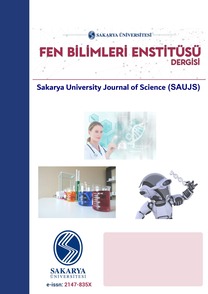Cıvata soğuk dövme işleminde kalıp ömrünün arttırılması: dövme kademe tasarımının etkisi
Tool life enhacement in cold bolt forging process: effect of forging stage design
___
- T.-W. Ku and B.-S. Kang, "Tool design for inner race cold forging with skew-type cross ball grooves," Journal of Materials Processing Technology, vol. 214, no. 8, pp. 1482-1502, 8// 2014.
- K. Wagner, A. Putz, and U. Engel, "Improvement of tool life in cold forging by locally optimized surfaces," Journal of Materials Processing Technology, vol. 177, no. 1-3, pp. 206-209, 2006.
- B. He, "Failure and Protective Measures on Punch & Die for Cold Extrusion," presented at the The 2nd International Conference on Computer Application and System Modeling, 2012.
- K. Andreas and M. Merklein, "Influence of Surface Integrity on the Tribological Performance of Cold Forging Tools," Procedia CIRP, vol. 13, pp. 61-66, 2014.
- S.-Y. Hsia and P.-Y. Shih, "Wear Improvement of Tools in the Cold Forging Process for Long Hex Flange Nuts," Materials, vol. 8, no. 10, pp. 6640-6657, 2015.
- P. Skov-Hansena, J. G. Niels Bayb, and P. Brùndstedd, "Fatigue in cold-forging dies: tool life analysis," Journal of Materials Processing Technology, vol. 95, pp. 40-48, 1999.
- S. Jhavar, C. P. Paul, and N. K. Jain, "Causes of failure and repairing options for dies and molds: A review," Engineering Failure Analysis, vol. 34, pp. 519-535, 12// 2013.
- H. J. Bunge, K. Pöhlandt, A. E. Tekkaya, and D. Banabic, Formability of Metallic Materials: Plastic Anisotropy, Formability Testing, Forming Limits. Berlin: Springer, 2000.
- M. Geiger, M. Hansel, and T. Rebhan, "Improving the fatigue resistance of cold forging tools by FE simulation and computer aided die shape optimization," Proceedings of the Institution of Mechanical Engineers, Part B: Journal of Engineering Manufacture, vol. 206, pp. 143-150, 1992.
- H. Berns, A. Melander, D. Weichert, N. Asnafi, C. Broeckmann, and A. GroβWeege, "A new material for cold forging tools," Computational Materials Science, vol. 11, no. 3, pp. 166-180, 5// 1998.
- V. Vazquez, D. Hannan, and T. Altan, "Tool life in cold forging-an example of design improvement to increase service life," Journal of Materials Processing Technology, vol. 98, pp. 90-96, 2000.
- U. Engel and U. Popp, "Microtexturing of Cold-Forging Tools - Influence on Tool Life," Proceedings of the Institution of Mechanical Engineers, Part B: Journal of Engineering Manufacture, vol. 220, no. 1, pp. 27-33, 2006.
- H. C. Lee, M. A. Saroosh, J. H. Song, and Y. T. Im, "The effect of shrink fitting ratios on tool life in bolt forming processes," Journal of Materials Processing Technology, vol. 209, no. 8, pp. 3766-3775, 2009.
- T.-W. Ku and B.-S. Kang, "Tool design and experimental verification for multi-stage cold forging process of the outer race," International Journal of Precision Engineering and Manufacturing, vol. 15, no. 9, pp. 1995-2004, 2014.
- S. Yurtdaş, U. İnce, C. Kılıçaslan, and H. Yıldız, "A Case Study for Improving Tool Life In Cold Forging: Carbon Fiber Composite Reinforced Dies," Research on Engineering Structures & Materials, 2016.
- K. Pöhlandt, "Testing tool materials for bulk metal forming," in Materials testing for the metal forming industry: Springer, 1989, p. 176.
- ISSN: 1301-4048
- Yayın Aralığı: 6
- Başlangıç: 1997
- Yayıncı: Sakarya Üniversitesi Fen Bilimleri Enstitüsü
Karabük sanayi bölgesi heyelanında güvenliğin sağlanması
AŞKIN ÖZOCAK, SEDAT SERT, ERTAN BOL
İmalat hücresi oluşturulması için farklı kümeleme yöntemlerinin performans karşılaştırması
Fatih TÜYSÜZ, Sinem BÜYÜKSAATÇI KİRİŞ
Kirlenmiş topraklardaki p,p'-DDE'nin kabak bitki özsuyu ile ilişkili biriktirme mekanizması
Mehmet İŞLEYEN, Ahmet AYGÜN, Beytullah EREN
MUSTAFA AYDIN, MEHMET AFŞAR, M. Bahattin ÇELİK
Oxley modelleme yaklaşımının tahmin doğruluğu ve verimliliğinin arttırılması
Yaşam döngüsü analizinin ambalaj atıklarının yönetiminde kullanılması
Typical cracks in deck of ship-shaped structures and ways to modify and improve the design
Ali Bahadır OLCAY, Ahmet Çağrı DEVELİ
ZEYNEP PARLAR, Eray Kaan SOYBORA, Mustafa Sefa BURHAN, Sena DAVASLIGİL
Enes KİLİNC, M. Abdullah SARİ, FATİH UYSAL, Erdal ÇELİK, HÜSEYİN KURT
